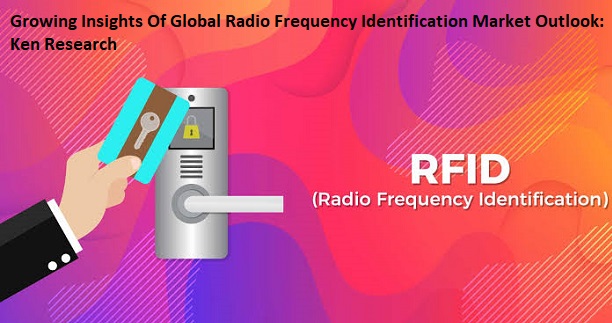Driven by the need for high accuracy and cost-effective features in banking, healthcare, retail, logistic industries, and other sectors, the Global Chipless Radio Frequency Identification Market is Forecasted to reach ~US$ 6 Bn by 2028 says Ken Research Study.
A Chipless RFID is a form of RFID tag that transmits data using radiofrequency (RF) radiation. A chipless RFID tag does not contain an application-specific integrated circuit (ASIC), hence the reader performs all signal processing to read the tags. It uses conductive polymers or plastic as an alternative to integrated circuits made from silicon.
Chipless Radio Frequency Identification (RFID) is used for access controls, automatic identifications, security and surveillance, tracking, database management, logistics, and inventory control in various industries like retail, healthcare, logistics, and transport among others.
1. Specialized Needs in Industries for Access Control, Identification, Security & Tracking, and Inventory Control have Created a Demand for Chipless RFID
The major applications of Chipless RFID tags are item-level tagging, product tracking, and surveillance. These are widely utilized for high-volume secure documents, smart ticketing, anti-counterfeiting, and asset tracking in various industries like retail, logistic & transport, healthcare sector, and other sectors.
According to Ken Research estimates, the Global Chipless Radio Frequency Identification Market –valued at ~US$ 1 Bn in 2017, is estimated to reach ~US$ 2 Bn in 2022 – and is expected to showcase ~US$ 6 Bn opportunity by 2028. Ken Research shares 5 key insights on market from its latest research study.
2. High Demand for Chipless RFID from Pharma Industry, Companies Witnessed Exponential Growths
Due to the lack of vigilance by healthcare service providers, there is an increase in drug counterfeiting. As traditional RFID with barcode technology is unable to prevent counterfeiting drugs, the healthcare sector is utilizing the need for chipless RFID devices to prevent such incidents.
In April 2019, Avery Dennison Corporation, a designer and manufacturer of a wide variety of labeling and functional materials, collaborated with Kit Check, for the implementation of RFID technology for big pharma manufacturers. This collaboration helped pharmaceutical companies to build their medication labels, enabling the tracking of each product from the point of manufacture to the point of final delivery.
According to Pharmaceutical Security Institute, there were 4344 pharmaceutical crime incidents, especially counterfeiting in the year 2020, which increased to 5987 cases in 2021. By using chipless RFID tags, it now becomes easy for pharma companies to track the products and prevent counterfeiting.
3. Information Breach Causing a Slight Slowdown in the Chipless RFID Demand
Despite all of its benefits, chipless radio frequency identification has an increased risk of a data breach as it lacks a locking system or security passcode. Owing to the risk of data breaches involving the use of medications and their composition, many businesses in the healthcare and other sectors avoid using chipless RFID tags for asset tracking. These factors are expected to hamper its acceptance by end-users and consequently limit the growth of the market.
In the USA, the annual number of data compromised in 2019 was 1279 million which reached almost 1862 million in 2021. This humongous number is a major concern for various industries in protecting their data.
4. Ultra-High Frequency Segment Observes a Wide Usage in Electronic Toll Collection and Parking Access Control
The Ultra high-frequency segment dominated the Global Chipless Radio Frequency Identification Market in 2021 and is estimated to continue being the dominant segment during the forecast period. These are widely used in electronic toll collection and parking access control for seamless flow of traffic, which contribute to the demand for ultra-high-frequency radio active identification tags.
According to the National Payments Corporation of India (NPCI), in India, toll collection in slow lanes using FASTag in January 2019 was US$ 65 Mn, and in November 2019, this figure reached US$ 98 Mn. FASTag is an e-toll collection device that uses ultra-high frequency RFID technology.
5. Advanced Pharma, Transportation, and Retail Sector helps in North America’s Dominance; the Asia Pacific shows the Fastest Growth Rate
North American companies are highly investing in moving toward implementing automated item identification systems for supply chain management to improve the efficacy of inventory allocation. Secondly, the growing demand for RFID technology in the healthcare sector is propelling the growth of the market in this region.
Asia Pacific region has a larger population and is witnessing advancements in healthcare, retail, and manufacturing sectors, along with the adoption of new technologies. Countries such as Japan, South Korea, China, India, Australia, New Zealand, and ASEAN are showing interest in the advanced/chipless RFID technology, as it is affordable and derives benefits in the long term. RFID technology is largely adopted by the healthcare industry players in Japan. China is using RFID labels in the logistics sector to improve its production network in the country. These factors boost the growth of the chipless radio frequency identification market in the Asia Pacific Region.
In April 2018, Tencent demonstrated the operation of an unmanned retail store in China, wherein the customer can easily select the product and exit the store without waiting in the billing queue. The RFID chip scans the associated product and sends the bill to the customer’s WeChat pay application.
For more information on the research report, refer to the below link:-
Global Chipless Radio Frequency Identification Market
Contact Us: –
Ken Research
Ankur Gupta, Head Marketing & Communications
Support@kenresearch.com
+91-9015378249






